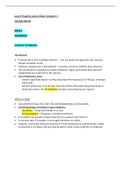Class notes
PVL2002 (Property Law) Semester 1 Notes
- Course
- Institution
These are complete, comprehensive, and understandable lecture notes for semester 1 of the PVL2002 - Property Law course. The lecture notes include content summaries, covering: the introduction, subjective rights, servitudes, the doctrine of notice, spoliation & possession, evictions/PIE & the manda...
[Show more]



